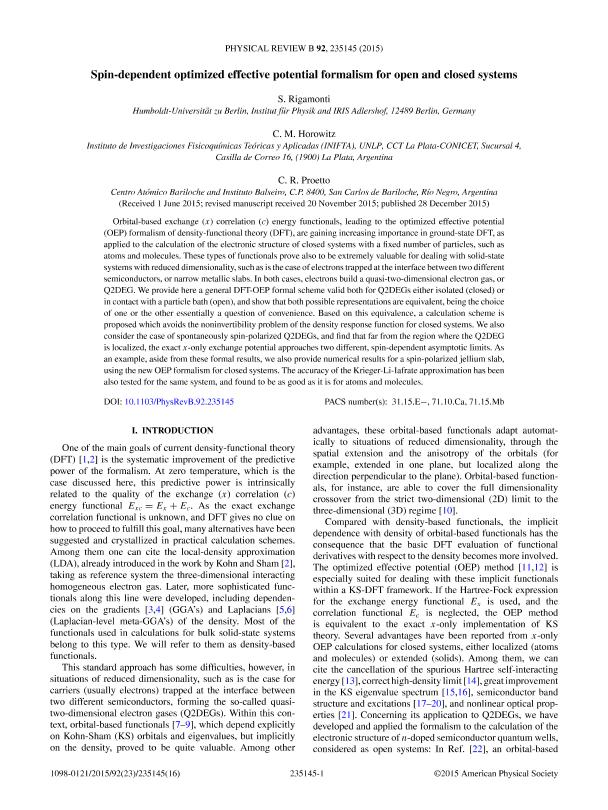Mostrar el registro sencillo del ítem
dc.contributor.author
Rigamonti, Santiago
dc.contributor.author
Horowitz, Claudio

dc.contributor.author
Proetto, Cesar Ramon

dc.date.available
2016-05-03T14:14:19Z
dc.date.issued
2015-12
dc.identifier.citation
Rigamonti, Santiago; Horowitz, Claudio; Proetto, Cesar Ramon; Spin-dependent Optimized Effective Potential formalism for open and closed systems; American Physical Society; Physical Review B: Condensed Matter and Materials Physics; 92; 23; 12-2015; 235145-235145
dc.identifier.issn
1098-0121
dc.identifier.uri
http://hdl.handle.net/11336/5462
dc.description.abstract
Orbital-based exchange (x) correlation (c) energy functionals, leading to the Optimized Effective Potential (OEP) formalism of density-functional theory (DFT), are gaining increasing importance in ground-stateDFT, as applied to the calculation of the electronic structure of closed systems with a fixed number of particles, like atoms and molecules. These types of functionals prove also to be extremely valuable for dealing with solid-state systems with reduced dimensionality, such as is the case ofelectrons trapped at the interface between two different semiconductors, or narrow metallic slabs.In both cases, electrons build a quasi-two-dimensional electron gas, or Q2DEG.We provide here a general DFT-OEP formal scheme valid both for Q2DEG´s either isolated (closed) or in contact with a particle bath (open), and show that both possible representations are equivalent, being the choice of one or the other essentially a question of convenience. Based on this equivalence, a calculation scheme is proposed which avoids the non-invertibility problem of the density response function forclosed systems.We also consider the case of spontaneously spin-polarized Q2DEG´s, and findthat far from the region where the Q2DEG is localized, the exact $x$-only exchange potential approaches two different, spin-dependent asymptotic limits. As an example, besides these formal results, we also provide numerical results for a spin-polarized jellium slab, using the new OEP formalism for closed systems. The accuracy of the Krieger-Li-Iafrate (KLI) approximation has been also tested for the same system, and found to be as good as it is for atoms and molecules.
dc.format
application/pdf
dc.language.iso
eng
dc.publisher
American Physical Society

dc.rights
info:eu-repo/semantics/openAccess
dc.rights.uri
https://creativecommons.org/licenses/by-nc-sa/2.5/ar/
dc.subject
Dft
dc.subject
Optimized Effective Potential
dc.subject
Q2deg
dc.subject.classification
Física de los Materiales Condensados

dc.subject.classification
Ciencias Físicas

dc.subject.classification
CIENCIAS NATURALES Y EXACTAS

dc.title
Spin-dependent Optimized Effective Potential formalism for open and closed systems
dc.type
info:eu-repo/semantics/article
dc.type
info:ar-repo/semantics/artículo
dc.type
info:eu-repo/semantics/publishedVersion
dc.date.updated
2016-05-06 15:52:43.262787-03
dc.journal.volume
92
dc.journal.number
23
dc.journal.pagination
235145-235145
dc.journal.pais
Estados Unidos

dc.journal.ciudad
New York
dc.description.fil
Fil: Rigamonti, Santiago. Humboldt-Universität zu Berlin; Alemania
dc.description.fil
Fil: Horowitz, Claudio. Consejo Nacional de Investigaciones Científicas y Técnicas. Centro Científico Tecnológico la Plata. Instituto de Investigaciones Fisicoquímicas Teóricas y Aplicadas; Argentina. Universidad Nacional de La Plata; Argentina
dc.description.fil
Fil: Proetto, Cesar Ramon. Comisión Nacional de Energía Atomica. Centro Atomico Bariloche; Argentina. Consejo Nacional de Investigaciones Científicas y Técnicas; Argentina
dc.journal.title
Physical Review B: Condensed Matter and Materials Physics

dc.relation.alternativeid
info:eu-repo/semantics/altIdentifier/url/http://journals.aps.org/prb/abstract/10.1103/PhysRevB.92.235145
dc.relation.alternativeid
info:eu-repo/semantics/altIdentifier/doi/10.1103/PhysRevB.92.235145
dc.relation.alternativeid
info:eu-repo/semantics/altIdentifier/doi/http://dx.doi.org/10.1103/PhysRevB.92.235145
Archivos asociados
